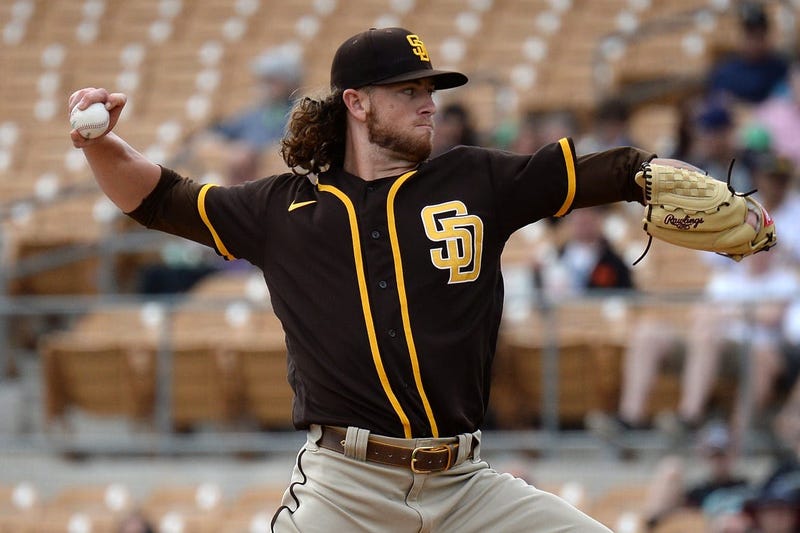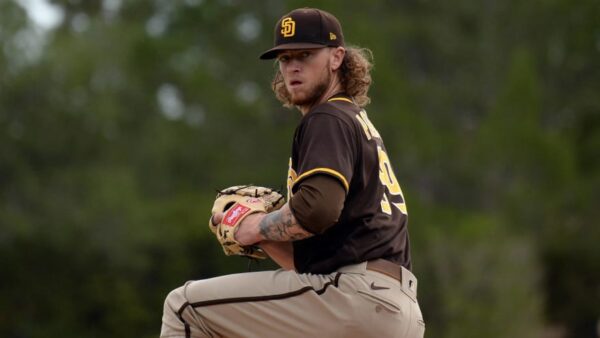Padres: Chris Paddack breaks down fastball struggles, workload for 2021

Photo credit Joe Camporeale-USA Today Sports

Chris Paddack’s sophomore season didn’t go as planned with the San Diego Padres, but he explained how he has corrected a couple of items to have a better 2021 season.
Following up on an impressive rookie season in which he posted a 3.33 ERA in 26 starts, Chris Paddack‘s 2020 season, albeit a shortened one, was a learning moment for the then 24-year-old. A number of his statistics regressed considerably, including nearly a run and a half higher ERA, increased hit and home run rates, and a decreased strikeout rate.
Paddack pitched in just one postseason game for the Padres, yielding six runs in 2.1 innings in the Wild Card round against the St. Louis Cardinals. In a way, it was the cherry on top in a down year, as Paddack went from the Padres ace to the team’s fifth starter.
He spent the offseason breaking down his primary pitch, which has tilted the success between his two big league seasons. While he has four pitches in his arsenal, the Austin, Texas native is primarily a two-pitch pitcher, broken down into 58.2 percent and 31.0 percent for his fastball and changeup, respectively.

In 2019, Paddack’s fastball yielded a .204 average against and .391 slugging percentage. Last season, his primary pitched yielded a .308 average against and .658 slugging percentage. The primary difference? Paddack’s fastball moved more left-to-right in 2020 versus up-and-down in 2019. According to StatCast, his fastball had two more inches – or 14 percent more – vertical movement than league average in 2019. Flash forward a year later, Paddack’s fastball had 0.6 fewer inches – or 4 percent less – vertical movement than league average.
“You know, being a taller pitcher on the mound, my biggest success rate is when I’m north to south,” the 25-year-old explained. “Last year, I was east to west. I was getting two-seam run on my four-seam fastball. At the big league level, the longer they see it in the zone, the harder they’re going to hit it. The biggest thing that I fixed was broke down a lot of video in 2019 as well as 2018 in the minor leagues of really breaking down mechanics on my front side. Basically, the term I use is staying grounded as long as I can with my legs and letting my upper body pinpoint the direction of whoever I’m throwing to that day.”
Broken down, his fastball went from 0.9 to 3.1 more inches of horizontal break than league average in 2019 compared to last season. Simply put, Paddack’s fastball was catching far too much of the strike zone.
With the Padres’ additions to the starting rotation this season, it’s understandable for Paddack to feel like an afterthought. All the attention goes to guys like Blake Snell, Yu Darvish, and Dinelson Lamet. But in another sense, less pressure can be a good thing for Paddack as he looks to return to 2019 form.
The Sheriff looks locked in. pic.twitter.com/jib4QQP0jZ
— 97.3 The Fan (@973TheFanSD) February 22, 2021
As for how many innings or where Paddack slots into the Padres rotation, that remains to be determined.
“We haven’t talked about it, attacking the season on how we’re going to do it,” Paddack told the media. “I’m just going to make sure I’m ready to go. There’s going to be some challenges going from 60 to 162 [games]. Our goal is to play more than 162. Like we said last spring, it’s going to take all of us in the clubhouse in spring training to contribute and get where we want to go. It sucks to say, but injuries are going to happen, but we’re trying to do everything we can to make sure we’re ready to go for the season. The guys behind us, they got our back. 60 to 162, man, it’s going to be challenging, for sure.”
Just based on the names in the rotation and where they pitched last year, Paddack likely makes the most sense as the Padres fourth or fifth starter, which shouldn’t be taken negatively. Paddack’s changeup yielded similar results from 2019 to 2020, and he dabbled with using his curveball more often in 2020.
“The way I like to explain it now is confidence on all my pitches is there,” Paddack said. “I think I’ve really lacked that over the last couple of years, really trusting those pitches. Going back to the analytical side of things, I think I threw my curveball four-to-five percent of the time last season. At the big league level, that’s not going to cut it. You gotta be able to show three, four pitches to have some success. You know, the curveball, I’m pretty hard on myself, but I’m really liking the shape, really liking the velo[city] where it’s coming out so far. Being able to get some feedback from our hitters as well as our coaches is going to be really good for me going into spring.”
Still, it will be critical for Paddack’s success in 2021 to get his fastball back on track, but having another pitch that can keep batters off-balance will go a long way toward the Padres getting where they want to go.
Padres writer/editor for East Village Times. LA Kings writer/editor for Hockey Royalty. IBWAA member.
We need Paddack to be right in 2021. We need him to be the stud pitcher he is capable of being for years to come. We have a great staff. We have a great staff in the minors as well. But, any team is an injured arm away from being great as compared to good. Great teams win playoff games and good teams watch them play.
When your team’s fifth starter can be as good as Chris can be, you know you’re loaded for a WS run.
It’s likely he’s his own worst enemy when he’s not pitching well. I hope he’ll mature enough to handle the rigors of a full season and the ups and downs that may accompany it. We need him to be better than good.
Yeah, if he can get his fastball right and more consistency from his curveball, both Paddack and the Padres should be in good shape 🙂